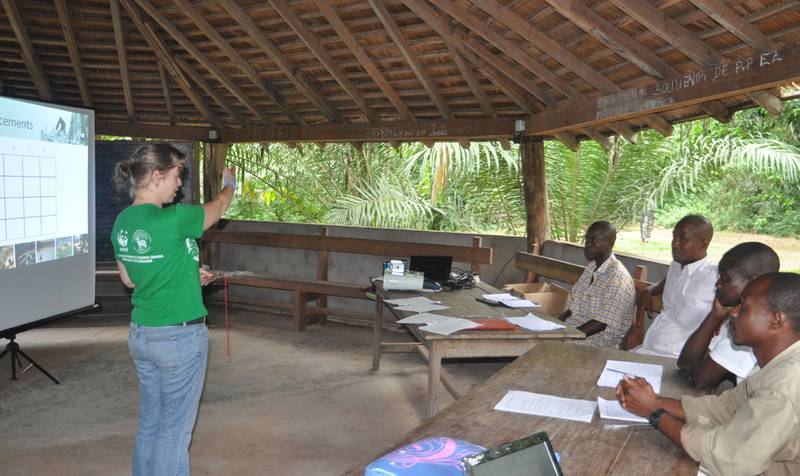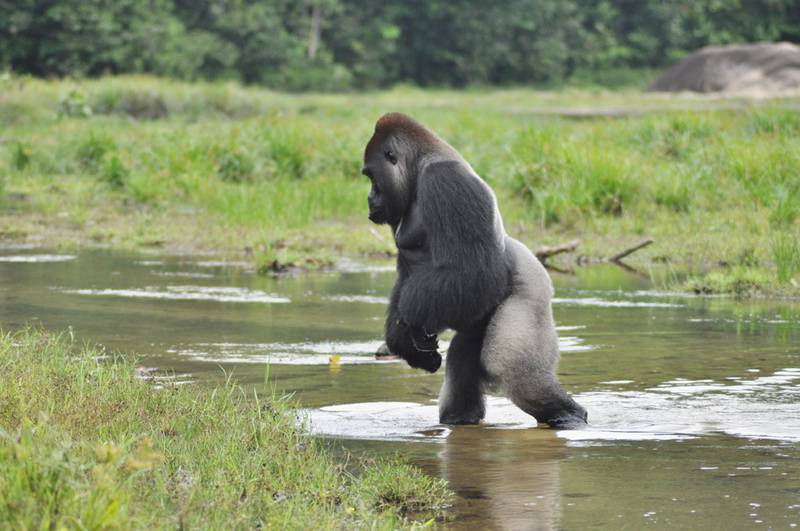Guide Refresher Training at Bai Hokou and Mongambe
Categories: Tourism, Journal no. 45, Protective Measures, Other countries, Other protected areas, Western Lowland Gorilla, Gorilla Journal

Angelique Todd providing training to the guides on the collection of gorilla ranging data, June 11th 2011 in Bayanga. During this part of the training the guides conducted a practical assessment regarding the mapping of ranging patterns, which is part of their daily activities. (© Thirza A. C. Loffeld)
The Primate Habituation Programme (PHP) in the Central African Republic is an integral part of the conservation activities of Dzanga-Sangha Protected Areas and aims to conserve the Critically Endangered western lowland gorilla (Gorilla gorilla gorilla) through habituation for research and tourism. So far, the PHP has greatly contributed to the conservation of western gorillas, protecting their habitat and supporting numerous studies on their ecology and behaviour. The PHP was initiated in 1998 at the Bai Hokou study site in the Dzanga-Ndoki National Park. The area includes a large number of forest clearings, named "bais", which attract high densities of wildlife to the area, and harbours significant populations of other mammal species including forest elephants, bongos, forest buffaloes and agile mangabeys, as well as a multitude of bird species. The gorillas therefore serve as a flagship species, raising international attention for the conservation of this area.
Today, the PHP has two research stations, Bai Hokou and Mongambe. There are currently two habituated gorilla groups, named after their silverbacks Makumba and Mayele, and a further two groups are under process of habituation. As a result of daily group follows, the locally-employed guides are uniquely placed to monitor the gorillas as well as to guide visitors and enforce tracking rules. To increase species knowledge and ensure the long-term well-being of the gorillas, project data are collected by guides on habituation level and behavioural ecology. Additionally, the PHP’s staff assess the health of the habituated gorilla groups via a health monitoring programme, whose goal is to collect data in order to assess the “normal” health status, i.e. baseline, and future risks (Todd, pers. comm.). It is thus of utmost importance to regularly evaluate the staff’s performance through training to ensure adherence to PHP protocols and revise and improve data collection standards.
Notwithstanding continuous direct anti-poaching efforts, the role of long-term field projects such as the PHP remains vital in the face of increasing human pressure, and given their long-term aim to prevent gorilla populations from declining further. High levels of training and expertise are required to obtain reliable and valid data on individual-based life history of the gorillas, and to facilitate tourism. Staff training is cited as the most common strategy to improve the staff’s job performance, and plays an important role in achieving institutional objectives (Stone 1997).
In the same manner, a number of studies or reports underline the importance of providing regular, high quality staff training in great ape habituation programmes to ensure adherence to the rules and to closely monitor these endangered animals (e.g. Hanes 2012; Homsy 1999; Macfie & Williamson 2010; Sandbrook & Semple 2006). In the previous issue of Gorilla Journal, Hanes (2012) described the risk of disease transmission between tourists and mountain gorillas habituated for tourism in Bwindi Impenetrable National Park, Uganda, principally arising as a result of the 7-m distance rule not being properly enforced and the subsequent extreme proximity of humans to the gorillas. One of Hanes’ recommendations is to provide the staff with more frequent and better quality refresher training in order to improve enforcements of the rules.
The Primate Habituation Programme currently employs just under 60 national staff and a varying number of national and international researchers and volunteers. Given the recent expansion of the PHP teams, it is a priority for the Dzanga-Sangha Protected Areas (DSPA) to organize in-depth training and knowledge assessment for new and old guides alike. Therefore a two-day guide refresher training program was designed and given by Angelique Todd, WWF Primate Habituation and Tourism Advisor for DSPA, in June 2011 to the nine PHP guides, divided into two groups.
Since the participants’ motivation to learn is essential to the success of training, a questionnaire was distributed among the guides two weeks before the training. The questions involved the guides’ 1) perceptions on the gorilla tracking rules and data collection methods, 2) opinions on conservation-related aspects of their job, and 3) job satisfaction, by asking about the challenges encountered in their job. Finally, the guides could indicate their preference for future training subjects and the frequency of training. The results of this questionnaire were incorporated into the design of the training so as to specifically tailor the training to the guides’ needs. When providing training, it is furthermore important that trainees are able to implement the knowledge and skills gained (Jacobson et al. 2006; Stone 1997). The PHP training was therefore based on real experiences and focused on interaction and practice. Monitoring and evaluation are imperative to the process of any training event (Kopylova & Danilina 2011). Adequate monitoring will allow small changes to be made during the training, adapting the training content, delivery techniques and materials used according to the needs of the target audience. Such evaluation permits training plans to be developed, adjusted and improved, and thenceforth enhances the effectiveness of training efforts by minimising the costs and increasing the programme’s credibility, such as to donors and foundations; the evaluation of training efforts furthermore enables documentation and distribution of information on successful programmes to beneficiaries (Jacobson & Robinson, 1990).
In this evaluation we appraised the effectiveness of the guide refresher training given in June 2011. Training was evaluated by 1) a practical assessment comprising the evaluation of the nine guides whilst collecting baseline data on the two groups of habituated western lowland gorillas (Makumba and Mayele) and by 2) a knowledge assessment involving a questionnaire pre- and post-training as a method to evaluate the nine guides' learning process. Data for the practical assessment were collected pre- and post-training over a total period of 8 weeks from May to July 2011. We compared each of the guides’ skills by means of tests for inter-observer reliability regarding data collection. The knowledge assessment consisted of a written test on gorilla biology, behaviour and ecology, rules and regulations, and data collection methods. The questions were designed based on the outcome of questionnaire A, and the "refresher" information given during the training reinforced the trainees' ability to answer these. To further assess the effectiveness of the training, questions were asked on the participants’ opinion on the training, as recommended by the IUCN guidelines on Protected Area Staff Training (Kopylova & Danilina 2011).
Results of the knowledge assessment illustrated that the training increased the knowledge of seven of the nine guides assessed. Contrary to our expectations, only three guides demonstrated an improvement in data collection methods, which may be explained by several reasons such as the small sample size per guide, resulting from time limitations, and the difference in experience between observers (varying from less than 6 months to up to and over 10 years of experience). However, when we removed outliers (N = 2), the experienced guides as well as the less experienced guides demonstrated an increase in inter-observer reliability. High inter-observer reliability is only one of the conditions to ensure validity of research (Caro et al. 1979), though it serves as an indicator that the data collection by the PHP guides became more standardised after the refresher training.
At both PHP's research stations western lowland gorillas are successfully habituated, which has contributed to the protection of this species while permitting both gorilla tourism and field research. An important aim of the PHP is to regularly evaluate their staff’s work performance and maintain high quality data collection as well as adequate enforcements of the gorilla tracking rules and regulations. The 2011 evaluation took place 1-4 weeks after the training, depending on the guides' work schedule. Recent guidelines however recommend evaluating the results of the training 3-12 months after the training, to assess changes over the longer term (Kopylova & Danilina 2011). The PHP would therefore like to continue systematic evaluation of training efforts and the dissemination of the lessons learned from future evaluations.
Through this study we fulfilled the objective of creating a standardised methodology for assessing guide training at the PHP, and furthermore collected baseline data for future PHP staff evaluations. We recommend that these types of evaluations become a permanent policy for all primate habituation programmes to ensure accurate long-term monitoring of habituated primates and continued animal wellbeing, and hence the sustainability of such conservation programmes.
Given that the process of evaluation is critical to the success of training, we would like here to call attention to the dearth of information on training evaluation assessments in great ape habituation programmes. With an eye on the future of our close relatives the gorillas, we would like to continue sharing the lessons learned from prospective training evaluations at the PHP with the conservation community.
Thirza A. C. Loffeld
This article is based on the results of more extensive MSc-research conducted by Thirza Loffeld. For further information about the questionnaire, practical assessment and/or knowledge assessments used at the 2011 training and evaluation at the Primate Habituation Programme, please contact Thirza Loffeld at thirzaloffeld@gmail.com. For further information on the Primate Habituation Programme please contact Angelique Todd at atodd@wwfcarpo.org.
We would like to thank the Ministry of Water, Forests, Hunting and Fishing and the Ministry of Education in the Central African Republic for their permission to undertake this study. My sincere thanks go to all the Bai Hokou and Mongambe staff. I am particularly grateful to Angelique Todd and Anna Feistner for their support and great contribution. Special mention goes to Terrence Fuh and all the guides. Their help has been vital to the completion of this study. Thanks go to Vincent Nijman and Susan Cheyne at Oxford Brookes University for their supervision of this research and Viridiana Jimenez for her help with the French translation. Acknowledgment of funding goes to Chester Zoo, the FONA Foundation for Nature Conservation, the Hendrik Muller Fund, the Foundation of Renswoude, and Oxford Brookes University.
References
Caro, T. M. et al. (1979): Interobserver reliability. Behaviour 69, 303-315
Hanes, A. C. (2012): The 7-metre gorilla tracking regulation. Gorilla Journal 44, 9-11.
Homsy, J. (1999): Ape tourism and human diseases; how close should we get? A Critical Review of the Rules and Regulations Governing Park Management & Tourism for the Wild Mountain Gorilla, Gorilla gorilla beringei. Rwanda: Report of a Consultancy for the International Gorilla Conservation Programme [Online]. Retrieved on April 21nd 2011 from: <link www.igcp.org/wp-content/themes/igcp/docs/pdf/homsy_rev.pdf _blank external-link-new-window>www.igcp.org/wp-content/themes/igcp/docs/pdf/homsy_rev.pdf</link>
Jacobson, S. K. et al. (2006): Conservation Education and Outreach Techniques. Oxford University Press, Oxford, UK
Jacobson, S. K. & Robinson, J. G. (1990): Training the New Conservationist: Cross-disciplinary Education in the 1990s. Environmental Conservation 17, 319-327
Kopylova, S. L. & Danilina, N. R. (eds.) (2011): Protected Area Staff Training: Guidelines for Planning and Management. IUCN, Gland, Switzerland
Macfie, E. J. & Williamson, E. A. (2010): Best Practice Guidelines for Great Ape Tourism. IUCN/SSC Primate Specialist Group (PSG), Gland, Switzerland
Sandbrook, C. & Semple, S. (2006): The rules and the reality of mountain gorilla Gorilla beringei beringei tracking: how close do tourists get? Oryx 40 (4), 428-433
Stone, R. (1997): What’s your role? Training or Organisational Impact. A Guide for Training Officers in Protected Area Management. African Biodiversity Series No. 5, Biodiversity Support Programme: Washington D. C., USA [Online]. Retrieved on 3 August 2011 from Biodiversity Support Program publications database: <link www.bsponline.org/publications _blank external-link-new-window>http://www.bsponline.org/publications</link>

